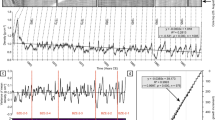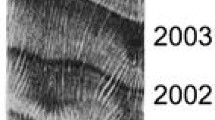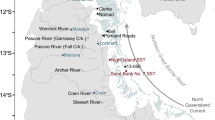Abstract
Studies on the growth response of corals to changing climate have largely focused on long-lived corals with relatively distinct density bands such as massive Porites corals. Little is known about the climatic response of other more abundant growth forms, such as branching Acropora corals, largely because of the absence of a clear annual density banding pattern. Using a combination of X-radiography, gamma densitometry, Sr/Ca analysis, and Uranium–Thorium (U-Th) dating, we quantified patterns of annual growth in the robust branching coral Isopora palifera from the central Great Barrier Reef (GBR), Australia (18°16′S 147°22′E) collected in May 2013. While visual analysis of the positive X-radiographs revealed alternating patterns of high- and low-density bands along the central growth axis, gamma-densitometry analysis suggests that these bands do not exhibit a clear annual cycle. In contrast, skeletal Sr/Ca ratios consistently revealed clear patterns of seasonality matching local sea surface temperatures (SST), and provided a growth chronology to calculate linear extension rate, skeletal density and calcification rate. Comparisons between SST-Sr/Ca calibrations derived from our I. palifera samples with (i) massive Porites from the same location and (ii) Isopora spp. from the GBR and Papua New Guinea revealed significant differences of up to 3.5 °C, implying palaeoclimate reconstructions should use site-specific and species-specific Sr/Ca-SST calibrations. Our approach provides a robust method for assessing changes in growth for a common Indo-Pacific branching coral, and provides a valuable framework for quantifying past and future changes in skeletal growth in response to climate change.





Similar content being viewed by others
References
Alibert C, McCulloch MT (1997) Strontium/calcium ratios in modern Porites corals from the Great Barrier Reef as a proxy for sea surface temperature: Calibration of the thermometer and monitoring of ENSO. Paleoceanography 12:345–363. doi:10.1029/97pa00318
Anderson KD, Heron SF, Pratchett MS (2015) Species-specific declines in the linear extension of branching corals at a subtropical reef, Lord Howe Island. Coral Reefs 34:479–490. doi:10.1007/s00338-014-1251-1
Ayre DJ, Veron JEN, Dufty SL (1991) The corals Acropora palifera and Acropora cuneata are genetically and ecologically distinct. Coral Reefs 10:13–18. doi:10.1007/BF00301901
Bak RPM, Nieuwland G, Meesters EH (2009) Coral growth rates revisited after 31 years: what is causing lower extension rates in Acropora palmata? Bull Mar Sci 84:287–294
Barnes DJ, Lough JM (1989) The nature of skeletal density banding in scleractinian corals: fine banding and seasonal patterns. J Exp Mar Biol Ecol 126:119–134. doi:10.1016/0022-0981(89)90084-1
Barnes DJ, Lough JM (1992) Systematic variations in the depth of skeleton occupied by coral tissue in massive colonies of Porites from the Great Barrier Reef. J Exp Mar Biol Ecol 159:113–128. doi:10.1016/0022-0981(92)90261-8
Barnes DJ, Lough JM (1993) On the nature and causes of density banding in massive coral skeletons. J Exp Mar Biol Ecol 167:91–108. doi:10.1016/0022-0981(93)90186-r
Beck JW, Edwards RL, Ito E, Taylor FW, Recy J, Rougerie F, Joannot P, Henin C (1992) Sea-surface temperature from coral skeletal strontium/calcium ratios. Science 257:644–647
Brown BE, Cossins AR (2011) The potential for temperature acclimatisation of reef corals in the face of climate change. In: Dubinsky Z, Stambler N (eds) Coral reefs: an ecosystem in transition. Springer Netherlands, Dordrecht, pp 421–433
Budd AF, Wallace CC (2008) First record of the Indo-Pacific reef coral genus Isopora in the Caribbean region: two new species from the Neogene of Curaçao, Netherlands Antilles. Palaeontology 51:1387–1401. doi:10.1111/j.1475-4983.2008.00820.x
Buddemeier RW, Kinzie RA (1975) The chronometric reliability of contemporary corals. In: Rosenberg GD, Runcorn SK (eds) Growth rhythms and the history of the earth’s rotation. John Wiley, pp 135–147
Buddemeier RW, Maragos JE, Knutson DW (1974) Radiographic studies of reef coral exoskeletons: rates and patterns of coral growth. J Exp Mar Biol Ecol 14:179–199. doi:10.1016/0022-0981(74)90024-0
Cahyarini S, Pfeiffer M, Dullo WC (2009) Improving SST reconstructions from coral Sr/Ca records: multiple corals from Tahiti (French Polynesia). Int J Earth Sci (Geol Rundsch) 98:31–40. doi:10.1007/s00531-008-0323-2
Cardinal D, Hamelin B, Bard E, Pätzold J (2001) Sr/Ca, U/Ca and δ18O records in recent massive corals from Bermuda: relationships with sea surface temperature. Chem Geol 176:213–233. doi:10.1016/s0009-2541(00)00396-x
Carricart-Ganivet JP, Cabanillas-Terán N, Cruz-Ortega I, Blanchon P (2012) Sensitivity of calcification to thermal stress varies among genera of massive reef-building corals. PLoS One 7:e32859. doi:10.1371/journal.pone.0032859
Chalker B, Barnes D (1990) Gamma densitometry for the measurement of skeletal density. Coral Reefs 9:11–23. doi:10.1007/BF00686717
Clark TR, Roff G, Zhao J-x, Feng Y-x, Done TJ, Pandolfi JM (2014) Testing the precision and accuracy of the U–Th chronometer for dating coral mortality events in the last 100 years. Quat Geochronol 23:35–45. doi:10.1016/j.quageo.2014.05.002
Cooper TF, De’ath G, Fabricius KE, Lough JM (2008) Declining coral calcification in massive Porites in two nearshore regions of the northern Great Barrier Reef. Glob Change Biol 14:529–538. doi:10.1111/j.1365-2486.2007.01520.x
Cooper TF, O’Leary RA, Lough JM (2012) Growth of Western Australian corals in the anthropocene. Science 335:593–596. doi:10.1126/science.1214570
Corrège T (2006) Sea surface temperature and salinity reconstruction from coral geochemical tracers. Palaeogeogr Palaeoclimatol Palaeoecol 232:408–428. doi:10.1016/j.palaeo.2005.10.014
D’Olivo JP, McCulloch MT, Judd K (2013) Long-term records of coral calcification across the central Great Barrier Reef: assessing the impacts of river runoff and climate change. Coral Reefs 32:999–1012. doi:10.1007/s00338-013-1071-8
De’ath G, Lough JM, Fabricius KE (2009) Declining coral calcification on the Great Barrier Reef. Science 323:116–119. doi:10.1126/science.1165283
Dodge RE, Brass GW (1984) Skeletal extension, density and calcification of the reef coral, Montastrea annularis: St. Croix, U.S. Virgin Islands. Bull Mar Sci 34:288–307
Done TJ (1982) Patterns in the distribution of coral communities across the central Great Barrier Reef. Coral Reefs 1:95–107. doi:10.1007/bf00301691
Dunbar RB, Wellington GM (1981) Stable isotopes in a branching coral monitor seasonal temperature variation. Nature 293:453–455. doi:10.1038/293453a0
Fallon SJ, McCulloch MT, van Woesik R, Sinclair DJ (1999) Corals at their latitudinal limits: laser ablation trace element systematics in Porites from Shirigai Bay, Japan. Earth Planet Sci Lett 172:221–238. doi:10.1016/s0012-821x(99)00200-9
Fallon SJ, McCulloch MT, Alibert C (2003) Examining water temperature proxies in Porites corals from the Great Barrier Reef: a cross-shelf comparison. Coral Reefs 22:389–404. doi:10.1007/s00338-003-0322-5
Faraway JJ (2002) Practical regression and ANOVA using R. University of Bath
Felis T, McGregor HV, Linsley BK, Tudhope AW, Gagan MK, Suzuki A, Inoue M, Thomas AL, Esat TM, Thompson WG (2014) Intensification of the meridional temperature gradient in the Great Barrier Reef following the Last Glacial Maximum. Nat Commun 5:4102. doi:10.1038/ncomms5102
Gagan MK, Ayliffe LK, Hopley D, Cali JA, Mortimer GE, Chappell J, McCulloch MT, Head MJ (1998) Temperature and surface-ocean water balance of the mid-Holocene tropical Western Pacific. Science 279:1014–1018. doi:10.1126/science.279.5353.1014
Gallup CD, Olson DM, Edwards RL, Gruhn LM, Winter A, Taylor FW (2006) Sr/Ca-Sea surface temperature calibration in the branching Caribbean coral Acropora palmata. Geophys Res Lett 33:L03606. doi:10.1029/2005GL024935
Gladfelter E (1984) Skeletal development in Acropora cervicornis III. A comparison of monthly rates of linear extension and calcium carbonate accretion measured over a year. Coral Reefs 3:51–57. doi:10.1007/bf00306140
Greer L, Jackson JE, Curran HA, Guilderson T, Teneva L (2009) How vulnerable is Acropora cervicornis to environmental change? Lessons from the early to middle Holocene. Geology 37:263–266. doi:10.1130/G25479A
Hathorne EC, Gagnon A, Felis T, Adkins J, Asami R, Boer W, Caillon N, Case D, Cobb KM, Douville E (2013) Interlaboratory study for coral Sr/Ca and other element/Ca ratio measurements. Geochem Geophy Geosyst 14:3730–3750. doi:10.1002/ggge.20230
Highsmith RC (1979) Coral growth rates and environmental control of density banding. J Exp Mar Biol Ecol 37:105–125. doi:10.1016/0022-0981(79)90089-3
Houck JE, Buddemeier RW, Smith SV, Jokiel PL (1977) The response of coral growth rate and skeletal strontium content to light intensity and water temperature. In: Proceedings, 3rd international coral reef symposium, pp 425–431
Hudson JH (1981) Growth rates in Montastraea annularis: a record of environmental change in Key Largo Coral Reef Marine Sanctuary, Florida. Bull Mar Sci 31:444–459
Hughes TP (1987) Skeletal density and growth form of corals. Mar Ecol Prog Ser 35:259–266. doi:10.3354/meps035259
Klein R, Loya Y (1991) Skeletal growth and density patterns of two Porites corals from the Gulf of Eilat, Red Sea. Mar Ecol Prog Ser 77:253–259
Knutson DW, Buddemeier RW, Smith SV (1972) Coral chronometers: seasonal growth bands in reef corals. Science 177:270–272. doi:10.1126/science.177.4045.270
Kojis BL (1986) Sexual reproduction in Acropora (Isopora) species (Coelenterata: Scleractinia) I. A. cuneata and A. palifera on Heron Island reef, Great Barrier Reef. Mar Biol 91:291–309. doi:10.1007/BF00428623
LaVigne M, Grottoli AG, Palardy JE, Sherrell RM (2016) Multi-colony calibrations of coral Ba/Ca with a contemporaneous in situ seawater barium record. Geochim Cosmochim Acta 179:203–216. doi:10.1016/j.gca.2015.12.038
Le Bec N, Julliet-Leclerc A, Corrège T, Blamart D, Delcroix T (2000) A coral δ18O record of ENSO driven sea surface salinity variability in Fiji (south-western tropical Pacific). Geophys Res Lett 27:3897–3900
Lemley GM (2012) Assessing δ18O in the coral genus Isopora for reconstructing Indo-Pacific regional and seasonal climate variability. University at Albany, State University of New York
Lough JM (2008) Coral calcification from skeletal records revisited. Mar Ecol Prog Ser 373:257–264. doi:10.3354/meps07398
Lough JM, Barnes DJ (1989) Possible relationships between environmental variables and skeletal density in a coral colony from the central Great Barrier Reef. J Exp Mar Biol Ecol 134:221–241. doi:10.1016/0022-0981(89)90071-3
Lough JM, Barnes DJ (1990) Intra-annual timing of density band formation of Porites coral from the central Great Barrier Reef. J Exp Mar Biol Ecol 135:35–57. doi:10.1016/0022-0981(90)90197-k
Lough JM, Barnes DJ (1992) Comparisons of skeletal density variations in Porites from the central Great Barrier Reef. J Exp Mar Biol Ecol 155:1–25. doi:10.1016/0022-0981(92)90024-5
Lough JM, Barnes DJ (2000) Environmental controls on growth of the massive coral Porites. J Exp Mar Biol Ecol 245:225–243. doi:10.1016/s0022-0981(99)00168-9
Ludwig K (2012) User’s manual for Isoplot version 3.75–4.15: a geochronological toolkit for Microsoft Excel. Berkley Geochronological Center Special Publication
MacIntyre IG (1977) Distribution of submarine cements in a modern Caribbean fringing reef, Galeta Point, Panama. J Sediment Res 47:503–516
Manzello DP (2010) Coral growth with thermal stress and ocean acidification: lessons from the eastern tropical Pacific. Coral Reefs 29:749–758. doi:10.1007/s00338-010-0623-4
Marshall JF, McCulloch MT (2002) An assessment of the Sr/Ca ratio in shallow water hermatypic corals as a proxy for sea surface temperature. Geochim Cosmochim Acta 66:3263–3280. doi:10.1016/s0016-7037(02)00926-2
McClanahan TR, Ateweberhan M, Muhando CA, Maina J, Mohammed MS (2007) Effects of climate and seawater temperature variation on coral bleaching and mortality. Ecol Monogr 77:503–525. doi:10.1890/06-1182.1
McCulloch M, Fallon S, Wyndham T, Hendy E, Lough JM, Barnes D (2003) Coral record of increased sediment flux to the inner Great Barrier Reef since European settlement. Nature 421:727–730. doi:10.1038/nature01361
Mitsuguchi T, Matsumoto E, Abe O, Uchida T, Isdale PJ (1996) Mg/Ca thermometry in coral skeletons. Science 274:961–963
Mitsuguchi T, Matsumoto E, Uchida T (2003) Mg/Ca and Sr/Ca ratios of Porites coral skeleton: evaluation of the effect of skeletal growth rate. Coral Reefs 22:381–388. doi:10.1007/s00338-003-0326-1
Nguyen A, Zhao J, Feng Y, Hu W, Yu K, Gasparon M, Pham T, Clark T (2013) Impact of recent coastal development and human activities on Nha Trang Bay, Vietnam: evidence from a Porites lutea geochemical record. Coral Reefs 32:181–193. doi:10.1007/s00338-012-0962-4
Nishida K, Iguchi A, Ishimura T, Sakai K, Suzuki A (2014) Skeletal isotopic responses of the scleractinian coral Isopora palifera to experimentally controlled water temperatures. Geochem J 48:9–14. doi:10.2343/geochemj.2.0317
Nothdurft LD, Webb GE (2007) Microstructure of common reef-building coral genera Acropora, Pocillopora, Goniastrea and Porites: constraints on spatial resolution in geochemical sampling. Facies 53:1–26. doi:10.1007/s10347-006-0090-0
Oliver JK (1984) Intra-colony variation in the growth of Acropora formosa: extension rates and skeletal structure of white (zooxanthellae-free) and brown-tipped branches. Coral Reefs 3:139–147. doi:10.1007/bf00301958
Pätzold J (1984) Growth rhythms recorded in stable isotopes and density bands in the reef coral Porites lobata (Cebu, Philippines). Coral Reefs 3:87–90. doi:10.1007/bf00263758
Potts DC (1976) Growth interactions among morphological variants of the coral Acropora palifera. In: Mackie GO (ed) Coelenterate ecology and behavior. Plenum Publishing Corp., New York, pp 78–99
R Development Core Team (2014) R: A language and environment for statistical computing. R Foundation for Statistical Computing, Vienna
Randall RH (1981) Morphologic diversity in the scleractinian genus Acropora. In: Proceedings, 4th international coral reef symposium, pp 157–164
Roche RC, Abel RA, Johnson KG, Perry CT (2010) Quantification of porosity in Acropora pulchra (Brook 1891) using X-ray micro-computed tomography techniques. J Exp Mar Biol Ecol 396:1–9. doi:10.1016/j.jembe.2010.10.006
Roche RC, Abel RL, Johnson KG, Perry CT (2011) Spatial variation in porosity and skeletal element characteristics in apical tips of the branching coral Acropora pulchra (Brook 1891). Coral Reefs 30:195–201. doi:10.1007/s00338-010-0679-1
Roff G, Zhao J-X, Mumby PJ (2015) Decadal-scale rates of reef erosion following El Niño related mass coral mortality. Glob Change Biol 21:4415–4424. doi:10.1111/gcb.13006
Shen C-C, Lee T, Chen C-Y, Wang C-H, Dai C-F, Li L-A (1996) The calibration of D[Sr/Ca] versus sea surface temperature relationship for Porites corals. Geochim Cosmochim Acta 60:3849–3858. doi:10.1016/0016-7037(96)00205-0
Shirai K, Kawashima T, Sowa K, Watanabe T, Nakamori T, Takahata N, Amakawa H, Sano Y (2008) Minor and trace element incorporation into branching coral Acropora nobilis skeleton. Geochim Cosmochim Acta 72:5386–5400. doi:10.1016/j.gca.2008.07.026
Sun Y, Sun M, Lee T, Nie B (2005) Influence of seawater Sr content on coral Sr/Ca and Sr thermometry. Coral Reefs 24:23–29. doi:10.1007/s00338-004-0467-x
Tanzil JTI, Brown BE, Tudhope AW, Dunne RP (2009) Decline in skeletal growth of the coral Porites lutea from the Andaman Sea, South Thailand between 1984 and 2005. Coral Reefs 28:519–528. doi:10.1007/s00338-008-0457-5
Tanzil JTI, Brown BE, Dunne RP, Lee JN, Kaandorp JA, Todd PA (2013) Regional decline in growth rates of massive Porites corals in Southeast Asia. Glob Change Biol 19: 3011–3023 doi:10.1111/gcb.12279
Veron JEN, Wallace CC (1984) Scleractinia of Eastern Australia. Part V: Family Acroporidae. Australian Institute Marine Science Monograph Series v. 6. doi:10.5962/bhl.title.60641
Wallace C (1999) Staghorn corals of the world: a revision of the genus Acropora. CSIRO publishing, Collingwood.
Weber JN, White EW, Weber PH (1975) Correlation of density banding in reef coral skeletons with environmental parameters: the basis for interpretation of chronological records preserved in the coralla of corals. Paleobiology 1:137–149
Wei G, Sun M, Li X, Nie B (2000) Mg/Ca, Sr/Ca and U/Ca ratios of a Porites coral from Sanya Bay, Hainan Island, South China Sea and their relationships to sea surface temperature. Palaeogeogr Palaeoclimatol Palaeoecol 162:59–74. doi:10.1016/s0031-0182(00)00105-x
Yu K-F, Zhao J-X, Wei G-J, Cheng X-R, Chen T-G, Felis T, Wang P-X, Liu T-S (2005) δ18O, Sr/Ca and Mg/Ca records of Porites lutea corals from Leizhou Peninsula, northern South China Sea, and their applicability as paleoclimatic indicators. Palaeogeogr Palaeoclimatol Palaeoecol 218:57–73. doi:10.1016/j.palaeo.2004.12.003
Acknowledgements
We would like to thank Eric Matson of the Australian Institute of Marine Science for assistance in coral collection and sample preparation, Tara Clark at the Radiogenic Isotope Facility, The University of Queensland for assistance in U-Th dating and Alberto Rodríguez-Ramírez and Jani Tanzil for their invaluable inputs at the early stage of the study. This study was supported by an ARC Laureate Fellowship to PJM (FL0992179) and the Australian Institute of Marine Science.
Author information
Authors and Affiliations
Corresponding author
Ethics declarations
Collection of Isopora samples was approved by the Great Barrier Reef Marine Park Authority and the Queensland Parks and Wildlife Service (Permit Number G11/34408.1) and funded by the Australian Institute of Marine Science. No animal ethics research permit needed for invertebrates, however all procedures in processing and extracting the corals were in accordance with the ethical standards of the institutions at which the studies were conducted. All authors approved the final version of the manuscript and consent to submit has been received from all co-authors and institutions.
Additional information
Responsible Editor: A.G. Checa.
Reviewed by I. Coronado and an undisclosed expert.
Electronic supplementary material
Below is the link to the electronic supplementary material.
Rights and permissions
About this article
Cite this article
Razak, T.B., Mumby, P.J., Nguyen, A.D. et al. Use of skeletal Sr/Ca ratios to determine growth patterns in a branching coral Isopora palifera . Mar Biol 164, 96 (2017). https://doi.org/10.1007/s00227-017-3099-8
Received:
Accepted:
Published:
DOI: https://doi.org/10.1007/s00227-017-3099-8




